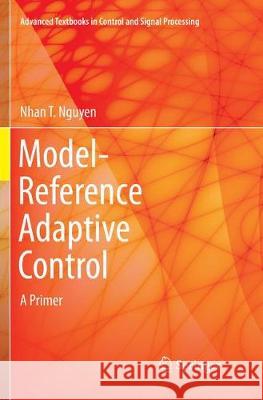Model-Reference Adaptive Control: A Primer » książka



Model-Reference Adaptive Control: A Primer
ISBN-13: 9783030096199 / Angielski / Miękka / 2018 / 444 str.
Model-Reference Adaptive Control: A Primer
ISBN-13: 9783030096199 / Angielski / Miękka / 2018 / 444 str.
(netto: 326,62 VAT: 5%)
Najniższa cena z 30 dni: 327,68
ok. 22 dni roboczych
Dostawa w 2026 r.
Darmowa dostawa!
MATLAB® files supplied to assist in working through exercises and examples. Solutions manual pdf.
"This book presents the fundamental theories of least-squares function approximation and least-squares adaptive control of systems with unstructured uncertainty. ... The book is intended for students beginning masters or doctoral courses, and control practitioners wishing to get up to speed in the subject expeditiously." (Vjacheslav Vasiliev, zbMATH 1405.93001, 2019)
Introduction.- Nonlinear Systems.- Mathematical Preliminaries.- Lyspunov Stability Theory.- Model-Reference Adaptive Control.- Least-Squares Parameter Identification.- Function Approximation and Adaptive Control with Unstructured Uncertainty.- Robustness Issues with Adaptive Control.- Robust Adaptive Control.- Adaptive Control Applications.
Dr. Nhan Nguyen is a research scientist at NASA Ames Research Center with 29 years of experience. He is the technical group leader of the Advanced Control and Evolvable Systems research group in the Intelligent Systems Division. He directs and leads 20 researchers, half hold Ph.D. degrees. He served as the NASA project scientist of the NASA Integrated Resilient Aircraft Control Project which had an annual budget of $21 million and a 90-person workforce, and funded 24 research grants in adaptive control to leading researchers in the field from 2007 to 2010. He currently leads a 16-person project team to conduct the development of an advanced aircraft control technology. He has published over 160 peer-reviewed technical publications including 120 publications in control theory and applications and three book chapters. He is the reviewer for many journals including IEEE Transaction on Automatic Control, AIAA Journal of Guidance Dynamics and Control, International Journal of Robust and Nonlinear Control, Automatica, and many others. He received several prestigious awards and medals including NASA Exceptional Scientific Achievement Medal, NASA Exceptional Achievement Medal, two-time NASA Ames Honors for Excellence as Engineer, NASA Space Act Award, and 30 other caeer awards. He holds one U.S. patent, and three patents pending. He has 10 other invention disclosures. He developed several innovative adaptive control methods in the 2000s, one of which was peer-reviewed and selected by NASA for flight-testing on NASA F/A-18A research aircraft. NASA only flight-tested two other adaptive control technologies previously: one on NASA X-15 aircraft in the 1960s and the other on NASA F-15 aircraft in the 2000s. He is the incoming chair of the American Institute of Aeronautics and Astronautics (AIAA) Intelligent Systems Technical Committee. He was the conference general chair of AIAA Infotech@Aerospace in 2012. He received an AIAA Distinguished Services Award. He is an adjunct professor at Santa Clara University where he teaches adaptive control, flight dynamics, and advanced dynamics, and aeroelasticity. He received the Lecturer-of-the-Year Award.
This book provides readers with a good working knowledge of adaptive control theory through applications. It is intended for students beginning masters or doctoral courses, and control practitioners wishing to get up to speed in the subject expeditiously.
Readers are taught a wide variety of adaptive control techniques starting with simple methods and extending step-by-step to more complex ones. Stability proofs are provided for all adaptive control techniques without obfuscating reader understanding with excessive mathematics.
The book begins with standard model-reference adaptive control (MRAC) for first-order, second-order, and multi-input, multi-output systems. Treatment of least-squares parameter estimation and its extension to MRAC follow, helping readers to gain a different perspective on MRAC. Function approximation with orthogonal polynomials and neural networks, and MRAC using neural networks are also covered.
Robustness issues connected with MRAC are discussed, helping the student to appreciate potential pitfalls of the technique. This appreciation is encouraged by drawing parallels between various aspects of robustness and linear time-invariant systems wherever relevant.
Following on from the robustness problems is material covering robust adaptive control including standard methods and detailed exposition of recent advances, in particular, the author’s work on optimal control modification. Interesting properties of the new method are illustrated in the design of adaptive systems to meet stability margins. This method has been successfully flight-tested on research aircraft, one of various flight-control applications detailed towards the end of the book along with a hybrid adaptive flight control architecture that combines direct MRAC with least-squares indirect adaptive control. In addition to the applications, understanding is encouraged by the use of end-of-chapter exercises and associated MATLAB® files; an electronic solutions manual for instructors can be downloaded from the book's page on www.springer.com.
Readers will need no more than the standard mathematics for basic control theory such as differential equations and matrix algebra; the book covers the foundations of MRAC and the necessary mathematical preliminaries.1997-2025 DolnySlask.com Agencja Internetowa
KrainaKsiazek.PL - Księgarnia Internetowa









